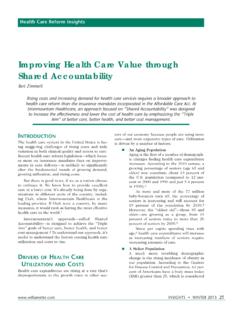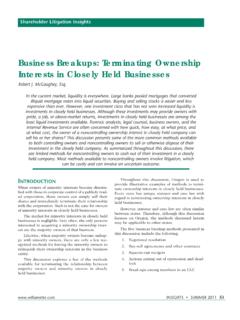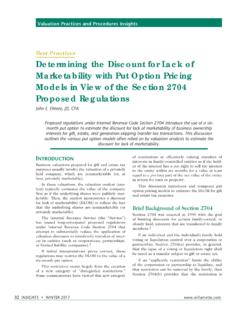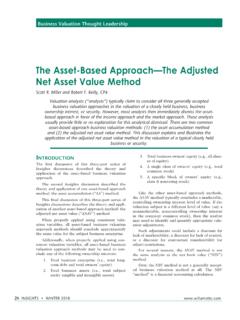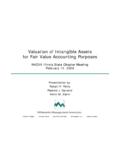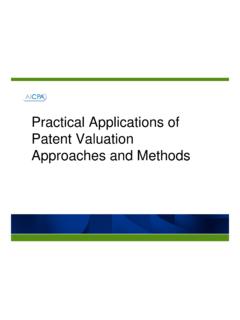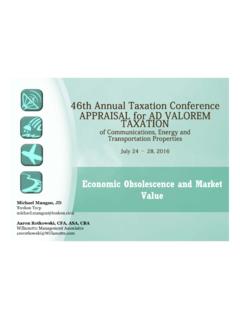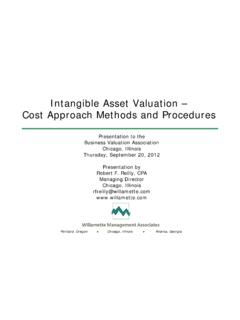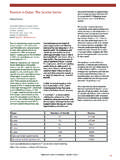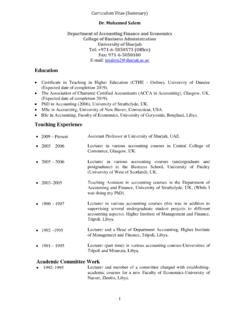Transcription of Joint Ventures Between Tax-Exempt Health Care ...
1 Www .willamette .com insights spring 2010 21 Joint Ventures Between Tax-Exempt Health care Organizations and For-Profit Parties:Avoiding Federal Tax Law TrapsLaVerne Woods, Esq., and Thomas C. Schroeder, care Regulatory and Compliance InsightsJoint Ventures Between Tax-Exempt Health care organizations and for-profit parties provide a popular approach to achieve enhanced medical operations, and increased access to and implementation of new medical technologies. This discussion analyzes the maze of federal tax issues that must be navigated in order to achieve the potential synergies that Joint Ventures last 25 years have seen an explosion in Joint Ventures Between Tax-Exempt Health care organiza-tions and for-profit parties. Indeed, the recent eco-nomic downturn has caused many Tax-Exempt Health care organizations and for-profit parties, including physician practice groups, to examine ways to con-solidate their operations.
2 One of the most common approaches is through a Joint term Joint venture has no precise legal definition. In this discussion we use the term to refer to arrangements in which a Tax-Exempt Health care organization , such as a hospital, clinic, or man-aged care organization , and one or more taxable, for- profit parties have agreed to provide capital or services in a common undertaking, and to share in some manner the income or losses from the Ventures involving Tax-Exempt Health care organizations fall into one of two categories: (1) ancillary Joint Ventures that involve an insub-stantial portion of the exempt entity s assets and activities, such as Ventures to create ambulatory surgery centers or to acquire and operate medical technologies, and (2) whole-entity or whole- hospital Joint Ventures , in which a Tax-Exempt entity contributes all or a substantial portion of its assets and operations to a Joint venture entity in partnership with a for-profit entity that contributes cash and/or assets.
3 Ancillary Joint Ventures are by far the more common type of Joint purpose of this discussion is (1) to identify the major federal tax issues that are unique to Joint Ventures Between Tax-Exempt Health care organiza-tions and for-profit parties and (2) to suggest ways that they can be structured to address those issues. Such Joint Ventures almost invariably also raise significant legal issues in other areas, including (1) federal and state anti-kickback laws, (2) the federal physician self-referral statute (commonly known as the Stark Law ), and (3) antitrust laws, all of which are beyond the scope of this discussion. It is important that any Joint venture structure take these issues into account as well. summary oF major tax laW IssuesOverviewA nonprofit Health care organization that is qualified for federal tax exemption under Section 501(c)(3)1 may permissibly engage in a Joint venture with for-profit parties, including physicians on its medical staff, without putting its tax exemption at risk, so long as the Joint venture structure meets certain insights spring 2010 www.
4 Willamette .comThe biggest concern for the exempt organization is of course preserving its Tax-Exempt status. The stakes are much higher in the context of whole- hospital Joint Ventures , in which the exempt organi-zation must ensure that it has sufficient control over the Joint venture so that the hospital will continue to be operated in a manner that satisfies the tax law standards of community benefit for exempt In the context of ancillary Joint Ventures , there is generally not a risk of loss of exemption so long as all transactions are at arm s length and for fair market is essential that all assets to be contributed to a Joint venture be valued appropriately to ensure that each party to the Joint venture receives an interest in the venture that is proportionate to its contributions. Any Joint venture in which not all transactions are at arm s length and for fair market value (1) may result in either private inurement or an impermissible level of private benefit and (2) could jeopardize the exempt organization s tax status.
5 The exempt organization s participation in the Joint venture may also constitute an unrelated trade or business. From the perspective of the for-profit participant, there is also the possibility of intermediate sanctions excise InurementPrivate inurement occurs when an insider 3 with respect to an exempt organization receives a benefit in excess of the fair market value of goods and ser-vices provided by the The level of risk to an exempt organization in a Joint venture depends to a significant degree on whether any of the other par-ties involved is considered an insider with respect to the exempt organization . The term insider is not precisely defined, but it clearly includes members of the organization s board, its officers, and their family members, entities owned by them, and likely others who may have a substantial level of influence over the organization ( , a key department head, or a medical group responsible for substantial hos-pital admissions).
6 As a general matter, an exempt organization should ensure that any transactions with for-profit parties are at arm s length and at fair market value. This becomes especially critical when the other party is an insider. The tax law s remedy for private inurement is revocation of the organiza-tion s Tax-Exempt SanctionsAny transaction that results in private inurement may also result in so-called intermediate sanc-tions on the party that received the undue The intermediate sanctions rules do not impose any liability on the Tax-Exempt organization itself. Rather, the rules were designed as an intermediate means of addressing private inurement transactions by penalizing the persons who benefit from such transactions, rather than (or in addition to) revok-ing the organization s , the intermediate sanctions rules authorize the Internal Revenue Service (IRS or the Service ) to impose an excise tax on any individual or entity who is a disqualified person 7 with respect to the exempt organization and who receives a ben-efit from the organization that exceeds the value of goods or services that the disqualified person pro-vides.
7 The tax is initially 25 percent of the excess Service may impose an additional tax equal to 200 percent of the excess amount if the dis-qualified person fails to correct the transaction by repaying the excess to the exempt An exempt organization officer or director who know-ingly approves an excess benefit transaction may also be personally liable for a tax of 10 percent of the excess private inurement rules and the intermedi-ate sanctions rules use different terms to describe the for-profit party s relationship with the organiza-tion ( , insider and disqualified person). Both sets of rules come into play, however, when there is a transaction Between the organization and a party that has substantial influence over the Treasury Regulations provide a procedure for creating a rebuttable presumption that a transaction is reasonable ( , not an excess ben-efit transaction) and, therefore, does not result in imposition of excise tax under the intermediate sanctions Specifically: (1) the arrangement must be approved by the independent members of the exempt organization s board or an authorized committee; (2) the board or committee must rely on 2010 , Cultura Limitedwww.
8 Willamette .com insights spring 2010 23 appropriate data as to the fair market value of the transactions; and (3) the board s or the committee s action must be documented concurrently in writing on a timely basis ( , in meeting minutes).12 While the rebuttable presumption procedures are technically a means to protect disqualified per-sons from liability for intermediate sanctions, as a practical matter an exempt organization that follows the procedures will also help to protect itself from a private inurement BenefitA Section 501(c)(3) organization is prohibited from conferring benefits that are more than incidental on private parties (whether or not insiders), except where the benefits are provided to a charitable class of beneficiaries, such as the poor, the sick, or the elderly. For benefits to be incidental, and therefore permissible, they must be both quantitatively and qualitatively be qualitatively incidental, a private benefit must occur as a necessary element of the activity that benefits the public at For example, a surgeon derives a private benefit from the use of a hospital s operating room.
9 However, this is a neces-sary element of the benefit to the general public from the availability of the combined resources of the hospital and its surgical be quantitatively incidental, a benefit must be insubstantial when viewed in relation to the pub-lic benefit that the activity An exempt organization that confers a private benefit that is more than incidental ( , by paying more than fair market value under a Joint venture management agreement) risks jeopardizing its tax Business Taxable IncomeAn exempt organization that regularly carries on a trade or business that is not substantially related to the organization s charitable purposes engages in an unrelated trade or Gross income from any such activity is unrelated business tax-able income (UBTI). UBTI is taxable to the exempt organization on a net basis at regular graduated cor-porate tax rates (or trust rates, if the organization is formed as a trust).
10 16 Most Joint Ventures , as discussed below, are structured as flow-through entities, which means that the exempt organization is treated as engaging directly in its proportionate share of the venture s As a result, every activity of the Joint venture has the potential to be an unrelated trade or business of the exempt organization , and to pro-duce UBTI. Any tax on UBTI will of course affect the organization s after-tax rate of return with respect to the reportIng and guIdanceReporting Joint Ventures on Form 990 The IRS Form 990, the annual information return filed by most Tax-Exempt organizations, underwent a major overhaul for the 2008 tax year. Among the new additions is a series of questions regarding the filing organization s governance and management practices. One such question asks whether the filing organization has invested in, contributed assets to, or participated in a Joint venture or similar arrange-ment with a taxable entity during the applicable tax An organization that answers yes to this ques-tion must indicate whether it has adopted a written policy or procedure requiring it (1) to evaluate its participation in such Joint Ventures and (2)

